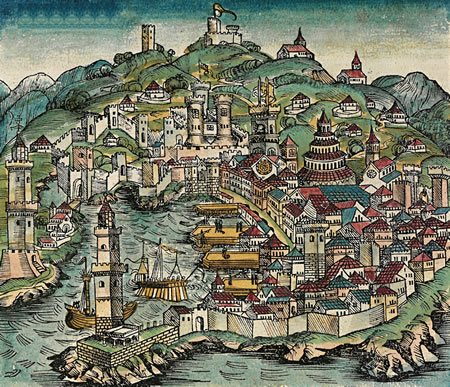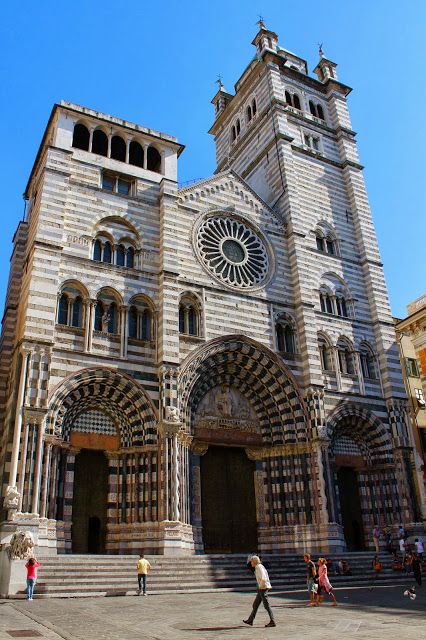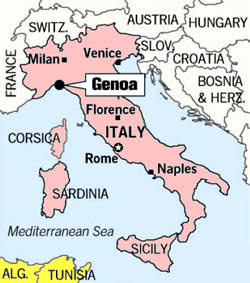 |
| Genoa |
The city of Genoa (Genova), in Liguria in northern Italy, was an important Roman port that was founded in the fourth century b.c.e. It is believed to have gained its name from the Latin word ianua, meaning door, as it served as an entry point for many goods being shipped to nearby places. During the medieval period Genoa emerged as an important maritime republic controlling trade in much of the Mediterranean.
The Roman connections with Genoa were largely severed in 641 c.e. when the Lombards invaded the region and captured the city. Over the next few centuries it weathered attacks by Barbary pirates from modern-day Algeria, who attacked much of the coastline and operated from bases in the nearby islands of Corsica and Sardinia. The citizens of Genoa put together a large naval force, captured the pirate bases on Corsica, and then attacked Sardinia and captured the island with the help of Pisa after 1284.
It was during this period that Genoa emerged as a major power, establishing colonies in North Africa, Syria, at Morea in modern-day Greece, and even as far away as the Crimea. This resulted in a strong trading position aided by the Crusades. They were also eager to increase trade with northern Europe. In 1379 a Genoese merchant was murdered in London when members of the “London mob” heard that he wanted to develop Southampton as a Genoese port.
  |
Consuls controlled political power in Genoa until 1191; however, the system ended and power shifted to the podesta (mayors) and then the Capitani del Popolo (Captains of the People), who ruled from 1258 until 1340, except for short periods when foreign leaders ruled them. During the 12th century work began on the construction of the Cattedrale di San Lorenzo, in the center of Genoa.
With a black and white striped Gothic marble facade (in part Romanesque and early Renaissance), now heavily identified with Genoese architecture, it included a Chapel to St. John the Baptist, designed by Semenico and Elia Gagini and built from 1451 until 1465.
It was said to have housed relics from St. John the Baptist, and a polished quartz platter on which Salome is said to have received the head of John the Baptist. It also held the Sacro Catino, a sacred cup that was supposedly given by the queen of Sheba to King Solomon, and later used by Jesus at the Last Supper. Salome’s plate and the sacred cup are currently in the cathedral’s museum.
 |
| The Cattedrale di San Lorenzo |
During this period the Venetians became jealous of the Genoese trade monopoly, and in 1298 the Genoese managed to defeat the Venetian fleet at the Battle of Curzola. During the battle the Genoese captured a Venetian nobleman called Marco Polo (1254–1324) and imprisoned him in Genoa for a year before sending him back to Venice. It was during his imprisonment that he wrote his Divisament du Monde (The Travels), about his visit to China.
In 1340 the Genoese decided to follow the Venetian custom of electing a doge, and the first was Simone Boccanegra. Under him and his successors Genoa flourished, and Genoese mercenaries became prominent in wars in Italy and in France. The money these mercenary bands earned massively enriched the city coffers.
In 1358 when the poet and humanist Petrarch visited the city he described it as “superb.” Two of the great seafarers of the 1490s were also born in Genoa. Christopher Columbus was born there in 1451, the son of a wool comber. He went to sea at the age of 14 and fought the Barbary pirates.
   |
When he was 19 he was shipwrecked and ended up working in Portugal, later offering his services to the king of Spain. Giovanni Caboto, “John Cabot,” was also born in Genoa in 1425. He moved to England in 1490, settling at Bristol. After the voyages of Columbus, he led English voyages across the Atlantic.
As with other city-states, the great families of Genoa fought each other for political power. The struggles among the Grimaldi, Dora, Spinola, and Fieschi families weakened the state and foreign powers vied for control of the city. Giovanni Visconti took control of the city government by force in 1353, holding it until 1356.
 |
| Genoa map |
The Sforzas were finally forced to flee in 1478 when the city rose up against them, but nine years later it was taken by Milan. Finally Andrea Doria (1466–1560), one of the great Genoese naval leaders, put together a constitution for Genoa that freed it of foreign domination but resulted in a dictatorial government that came to power after the Fieschi and the Cibo tried to seize power in 1547–48.